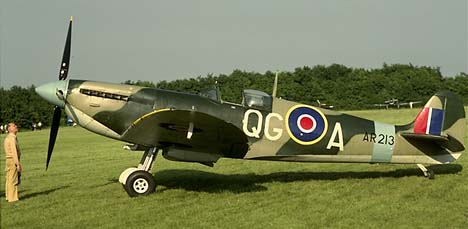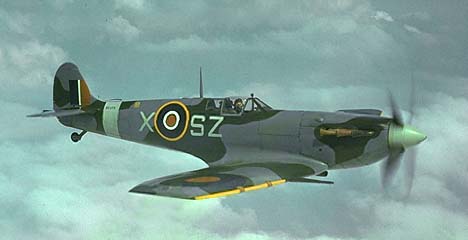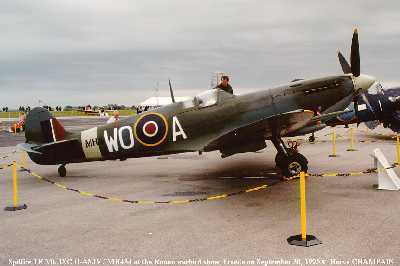flying the Supermarine Spitfire!
 |
The symbol of
Britain's refusal to give up during that dark summer of
1940, the Spitfire won the hearts of both pilots and
public in World War II. Regardless of the version, with
either Rolls-Royce Merlin or Griffon power, all Spitfire
cockpits are virtually identical and wonderfully
compact.Climbing in really is (to use a very worn turn of
phrase) like pulling the machine on. If everything is
done correctly, the Spitfire is one of the easiest
aircraft to start. The engine usually fires within two
blades and runs like a clock. |
While the
Merlin-engine versions run very smoothly, the larger
Griffon-engine machines feel as if they are angry. The sound from
the exhaust stacks and the vibration transferred to the seat of
the pants communicates visceral power, almost a desire to go kill
something. Any hot-rod lover would enjoy this sensation of
unbridled horsepower, this impatience to be turned loose and
hunt. Every fighter I've been in is great fun to fly but only a
very few are brutally straight about why they exist. The Griffon
Spitfire is one such machine.
With enough warmth
in the coolant and oil, a flip of the parking brake catch
releases the brake lever on the spade control grip and the
aircraft is taxiing with minimal power. The first time I had the
opportunity to fly a British aircraft with this hand operated air
brake system I was sceptical about it being very effective
compared to hydraulic toe brakes. Within a very few minutes I was
completely won over. It is far easier to manage, particularly on
run up when one has to really stand on most American fighter
rudder pedals. The source of high-pressure air is controlled by
the brake lever on the spade control grip, or stick. The rudder
pedals modulate the distribution of pressure to the left and
right main wheel brakes. If the pedals are even, equal braking is
applied to both sides; as one rudder pedal is applied then more
brake pressure is fed to that side. Strength of application is
delivered by the hand lever on the grip. The major benefit to all
this is having one's feet and legs almost completely relaxed most
of the time.
Lining up for
take-off is intimidating with that Rolls-Royce engine sticking
way out in front. There is no sense in thinking too much about
it. Throttle up slowly to prevent a lurch to the right (if in a
Griffon Spit where the propeller turns the opposite direction
from American aircraft)...left foot moves forward almost in
concert with the left hand to keep the nose straight. Monster
torque shoves the right wing down rapidly, very much like the
P-40, until full left aileron and full (give or take a minuscule
amount) left rudder is held. The Rolls is a wounded dragon
bellowing horrendously.
There is so much
raw power and noise, and you are so tightly focused on keeping
everything under control, the actual lift-off at around 90 kts
goes by almost unnoticed. Switch hands, move the gear lever down
to disengage it from the slot, inwards through the gate and then
smartly all the way forward, hold momentarily, then let go. If
all is well, the lever snaps outwards through the upper gate,
then springs back into the upper slot. Its easy to spot a new
Spitfire pilot...the aircraft porpoises as the pilot changes
hands and works the gear lever.
Sitting behind
this demon V-12 churning out so much power is intoxicating...the
earth falls away at a rapid rate, at least for something with a
propeller. A look around reveals the excellent visibility out of
the bubble canopy. This lessens, to a degree, the impression of
being buried within a Spitfire, though that feeling of being a
part of the machine does not change. The elevator is very light
while the rudder is stiff and the ailerons even more so. Every
Spitfire I've flown takes a bit more muscle to roll than most
fighters. As speed increases both rudder and ailerons get
heavier, resulting in a curious mismatch at high speed...one has
to handle the almost oversensitive elevators with a light
fingertip touch while arm-wrestling the stiff ailerons. Pilots
had to keep this in mind during combat, particularly when going
against the Fw 190 which had a sterling rate of roll and
exceptionally well harmonised controls. That being said, the
aircraft is very well balanced and delightful to manoeuvre.
Whipping a Spit around the clouds ranks right up there at the top
of aviation's great experiences.
 |
The aircraft stalls like a Piper
Cub. Though a wing tends to drop, there isn't the
slightest mean streak in it unless you cob the power,
which produces a very violent torque roll. Power off,
gear and flaps down, main fuel tanks full, it stalls at
65 kts, which is ridiculously slow. Add a slight bit of
power and that drops to 60 kts. With that enormous snout,
I try to make a curving approach to landing at about 100
kts in order to keep the runway in sight as long as
possible. |
By the time I'm rolling out across the
field boundary, if at max landing weight, I should be no faster
than 85 kts with power and 95 kts in a glide. At lighter weights
these speeds can be reduced by 5 kts.
All Spitfires are exceptionally easy to
land with no inherent tendency to swerve or groundloop. Just
reduce power to idle, flare to a three point attitude and she
sets down on a feather almost every time. This is a great
surprise to most considering the narrow track undercarriage and
full swivel, non-locking tailwheel. Why doesn't it drop a wing
violently or make the pilot stomp on the rudders? I wish I knew.
The genius of managing to combine light aircraft characteristics
with such high performance is nothing short of miraculous
compared to most other wartime tailwheel types. One or two
landings in the Spitfire and you are in love for life.
Article by Jeff Ethell ©1995

spitfire
brief history and technical information
.jpg) |
The Spitfire showing off it's
beautiful elliptical wing planform. This elliptical shape is the most
aerodynamically efficient form when it comes to induced
drag and wingtip vortices are reduced to a minimum.
It is a very "expencive"
construction though, because there are not two identical
ribs in the wing, so it's not very efficient in mass
production. But back in those days the engineers didn't
think that way.
|
The Supermarine Spitfire was
Britain's premiere fighter throughout the entire war. Pilots
found it to be agile and dependable, it was a fine air-combat
plane capable of great speed and superior high-altitude
performance. It was continuously upgraded so that it would match
or better the best German fighters at the time. Only until late
in the war when jet aircraft appeared was the Spitfire made
obsolete, although even then pilots in Spitfires shot down
Messerschmitt Me262 jets. It even served aboard aircraft carriers
as the Seafire.
The Spitfire was developed by
Reginald Mitchell through the 1930's military competitions to
replace the Bristol Bulldog fighters. It was named
"Spitfire" and it went in production in 1938 as the
Mk.I version. Many more versions followed that saw continual
modifications to the Merlin engine to wring more power from it.
The original cockpit suffered from a rear-ward vision problem, it
was eventually replaced with a teardrop shape originally designed
for the P51 Mustang. The propellor changed from a two-bladed
wooden one to a steel 5-bladed propellor. The armament increased
from eight machine guns to four cannons and bombs. When the
Merlin engine reached its limit in 1942 (its power had increased
from 990 hp to 1,730 hp), Supermarine turned to the Rolls-Royce
Griffon engine. A very successful version of the Spitfire (Mk
XIV) was a Mk.VII with a five-bladed propeller and a Griffon
engine. A new name, the "Victor" had been proposed, but
not adopted. This aircraft was superior to almost all German
fighters, except the last version of the FW190. The last version,
the Mk.22, was armed with four 20 mm cannons and had a very
powerful engine capable of catching V1 rockets. A total of 20531
Spitfires in 40 modifications were built. It remained in service
with various air forces for many years after the end of the war
and the Seafire naval variation was last used in combat by the
Royal Navy from the carrier HMS Triumph in the Korean war.
Technical Details
Production of the MkI began in 1937. It was powered by the
Rolls-Royce Merlin II of 1030 hp. This gave the Mk I a speed of
355 mph, a climb rate of 2515 ft/min, and a vey high ceiling of
34,556 ft (with oxygen of course). It came equipped with no fewer
than 8 0.3.3 Vickers K machine guns, 4 in each wing. A total of
1583 Mk.Is were made.
The Mk II went into service at
the end of 1940. It differed primarily in the adoption of the
R.R. Merlin XII of 1,175 hp. Two main variants were produced, the
MkIIA with eight machine guns and the MkIIB with four machine
guns and two 20 mm cannons. The MkIIs were definitely a
transitional aircraft to more powerful forms. 920 Mk.IIs were
made.
The Spitfire MkV was a
compromise between performance, Fliexibility of use and
firepower. They began to arrive at front line units in March
1941. Two types of wing were adopted, a standard one (known as
the F wing) and a clipped version (the LF wing) that had better
performance at lower altitudes. The armament became more diverse,
varying from eight machine guns in the MkVA, the four machine
guns and two cannons in the MkVB and the four cannons in the
MkVC. The VC version used a universal wing capable of fitting all
of the armament variations. The engines used were the Merlin 45
and 50, generating 1,440 and 1,490 hp, respectively. Of the MkV
series, only 94 MkVAs were made, 3,923 MkVBs were produced and
2,447 MkVCs were produced.
A variant of the MkV was
numbered the MkIV that was a MkV turned into a
photo-reconnaissance aircraft. The guns were removed and
additional fuel tanks were installed in the wings. Cameras were
installed in the rear of the fusilage, the wings were lengthened
with rounded tips and the cockpit was pressurized.
The MkIX series was powered by
the Rolls-Royce Merlin 61, 12 cylinder V, liquid-cooled,
generating 1,565 hp. It was developed in response to the
appearance of the Focke-Wulf 190 that, in 1942, was decided
superior to the MkV in everything except turn radius. This was
basically the MkV airframe married to the more powerful Merlin
engine. A total 5,665 were built in three basic subseries
designed for low, medium and high altitude combat (with the LF, F
and HF wings) and armament type (B, C or E) Bs and Cs had four
0.303 machine guns and two 20 mm cannons, and Es had two 12.7 mm
machine guns and two cannons and up to a 1,002 lb (454 kg) bomb
load. Numerous subvariants of the MkIX were produced and given
other numbers in the series.
The Mk.XIV was powered by the
Rolls-Royce Griffon 61 engine of 2035 hp. This popular version
had a maximum speed of 437 mph, a ceiling of 43,783 ft and a
range of 457 miles. It packed two 20 mm British-Hispano cannon
and two heavy 12.7 mm machine guns in the wings.
The last version, the Mk.XXII
used the same Griffon engine as the Mk XIV with a speed of 425
mph, but it had an increased range of 5567 miles. It carried
heavier armament, using four 20 mm British-Hispano cannons with
200 rounds each. A total of 278 Mk.22s were built.
| The Spitfire was a highly
respected opponent by the Luftwaffe pilots. At one time Luftwaffe ace Adolf Galland told
Göring, after his wing had been critisized for not
shooting down enough RAF fighters, to get him a wing of
Spitfires!
Click Galland's image to the right
to hear him tell about it.
|
 |

The Old Flying
Machine Company's Spitfire Mk. IX, the Spitfire where I got a
cockpit checkout by OFMC pilot Rolf Meum. My dream is that on a
sunny day.........
Close window